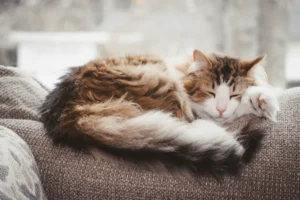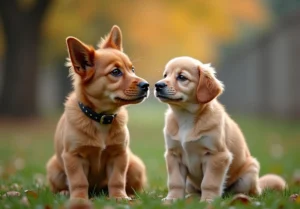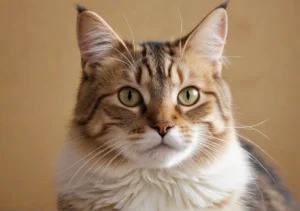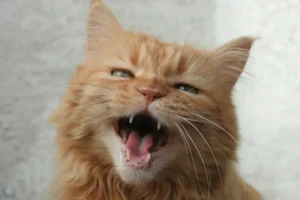Cats have a mysterious way of being irresistibly drawn to the sound of meows. Have you ever wondered why cats are so attracted to this particular noise? Let’s explore the fascinating reasons behind this feline behavior.
The Evolutionary Connection between Meows and Cats
Did you know that cats have developed a unique form of communication through meowing over the course of their evolution? Meowing is not something cats do with each other in the wild. It’s specifically a sound they make to communicate with us humans. It’s like they’ve learned a new language just for us!
One theory as to why cats are naturally attracted to meows is because they associate this sound with getting our attention. In the wild, cats meow to their mothers as kittens to signal hunger or distress. So when they meow at us, it’s like they’re trying to communicate their needs just like they did as babies. It’s their way of saying, “Hey, I need something!”
Cats are intelligent animals, and they quickly learn that meowing can get them what they want from their human companions. Whether it’s food, attention, or simply wanting to be let outside, they’ve made the connection that meowing equals getting a response from us. So, next time your cat meows at you, remember that they’re just using the tools they’ve learned to communicate with you effectively.
The Influence of Kittenhood on Cat Behavior
Kittens are like tiny chatterboxes! They meow at their mothers and littermates to communicate everything from hunger to playfulness. This early communication through meows plays a vital role in shaping their behavior as adult cats.
As kittens grow older, they begin to understand that meowing gets them what they want. Just like a baby crying for attention, a cat meows to grab our focus. This behavior carries over into adulthood, creating a strong association between meows and cats. It’s like they’ve learned that meowing is their secret weapon to ensure their needs are met.
So, the next time your cat meows at you, remember that it’s not just a random noise. It’s a form of communication deeply ingrained in them from their early days. By responding to their meows, you’re strengthening the bond between you and your feline friend.
The Impact of Human Interaction on Cats’ Meowing Behavior
Cats are masters of manipulation, especially when it comes to getting what they want. Over time, cats have learned that meowing is an effective way to communicate with humans and elicit a response. This behavior is reinforced through positive reinforcement – in other words, when a cat meows and receives attention, food, or affection in return, they learn that meowing gets them what they desire.
The key here is that cats have adapted their communication style to cater to human preferences. They have recognized that meowing is a sound that humans pay attention to and respond to, leading them to use it more frequently when they want something. So, the next time your cat meows incessantly for a treat or a cuddle, just remember that they have probably perfected this tactic to make sure they get their way.
The Role of Purring in Cat Communication
Purring is often associated with meowing and is another tool in a cat’s communication arsenal. While meowing is more commonly used to get attention or make requests, purring serves a different purpose. Cats purr not only when they are content but also when they are feeling anxious or in pain. It’s a versatile form of communication that can convey a range of emotions.
Interestingly, the combination of meowing and purring creates a powerful communication strategy for cats. When a cat meows to get your attention and then purrs when you respond, it creates a positive feedback loop that reinforces their behavior. This is why cats are so attracted to meows – it’s not just about getting what they want but also about building a deeper bond through communication.
Additional Unique Insight:
- Consider the tone and pitch of your cat’s meows – they may vary depending on what they are trying to communicate. High-pitched meows are often used for attention-seeking, while low-pitched meows can signal distress or displeasure. Paying attention to these subtle cues can help you better understand your cat’s needs and emotions.
The Connection between Meowing and Emotional Expression in Cats
Cats are natural communicators, and meowing is one of the primary ways they express their emotions. From the cute little meows for attention to the loud, insistent ones for food, cats use a variety of meows to convey their feelings. When your feline friend meows at you, they could be telling you they are hungry, lonely, happy to see you, or seeking affection. By responding to their meows with attention and care, you strengthen the emotional bond between you and your cat, creating a deeper connection based on mutual understanding and communication.
The Influence of Breed Characteristics on Cats’ Response to Meows
Different cat breeds have unique traits and characteristics that can influence how they respond to meows. Some breeds, like Siamese cats, are known for their vocal nature and may be more attracted to meows because they enjoy communicating with their human companions. On the other hand, more independent breeds like Maine Coons may not be as responsive to meows, as they prefer to express themselves in other ways. Understanding your cat’s breed characteristics can help you tailor your interactions with them, ensuring a harmonious relationship based on their specific needs and preferences.
Additional Insight:
– Persian cats are known for their quiet nature and may not meow as much as other breeds. If your Persian cat meows at you, it could indicate a strong desire for attention or care, so be sure to give them some extra love when they communicate in this way.
The Impact of Socialization on Cats’ Meowing Behavior
Have you ever wondered why some cats are more vocal than others? Well, it all comes down to their early socialization and experiences. Kittens that have positive interactions with humans and other cats tend to develop more communicative meowing habits. When a cat is raised in a nurturing environment with plenty of socialization opportunities, they learn that meowing is an effective way to get attention, food, or playtime.
On the other hand, cats that have had limited exposure to humans or other animals may not meow as much because they haven’t learned the value of vocal communication. This is why feral cats, for example, tend to be quieter than domesticated cats. So, if you want your cat to meow more, make sure to provide plenty of socialization opportunities and positive interactions to encourage vocal behavior.
The Intriguing Connection between Cats and Other Animals’ Vocalizations
Did you know that cats can respond to meows from other animals, not just from fellow felines? Cats are highly attuned to different vocalizations, including those made by dogs, birds, or even humans. This cross-species communication adds a layer of complexity to cats’ attraction to meows.
When a cat hears a meow from another animal, they may respond in a variety of ways. Some cats might become curious and investigate the source of the sound, while others may feel threatened or intimidated. It’s fascinating to see how cats interact with different species through vocal cues, showcasing their unique ability to communicate across boundaries.
Here are a few fascinating ways cats respond to other animals’ vocalizations: 1. Curiosity: Cats may show interest in the source of the meow, especially if it’s a sound they haven’t heard before. 2. Alertness: Some cats may perceive certain vocalizations as warnings or signals of danger, prompting them to be on high alert. 3. Aggression: In some cases, cats may respond to meows from other animals with aggression, especially if they feel territorial or threatened.
Next time you notice your cat reacting to a meow from another creature, take a moment to observe their behavior and see how they navigate this unique form of communication.
Fun Facts about Cats’ Meowing Behavior
Cats communicate through meows, but did you know that adult cats typically only meow at humans, not at other cats? Meowing is a behavior they develop to communicate with their human companions, mimicking the way kittens communicate with their mothers. Cats use different types of meows to convey various needs and emotions, such as hunger, attention, or simply wanting to engage in play. Interestingly, cats can also modify the pitch and volume of their meows depending on the response they want to elicit from their human. So, next time your feline friend meows at you, pay attention – they might have something important to say!
Meowing: A Distinct Form of Communication
- Attention-Seeking Meows: Cats may meow to get your attention or interact with you. This type of meow often involves short, repetitive sounds that serve as a way for cats to engage with their humans.
- Hunger Meows: If your cat is meowing insistently around feeding time, they are likely signaling their hunger. These meows are often more drawn-out and persistent.
- Greeting Meows: Cats may greet their humans with soft, gentle meows as a form of acknowledgment and affection. This type of meow is usually short and sweet.
- Annoyed Meows: When cats are irritated or annoyed, they may emit sharp or low-pitched meows to express their discontent. These meows serve as a warning or a signal to back off.
Next time your cat meows at you, pay attention to the context and pitch of the meow – they might be trying to tell you something important. Understanding your cat’s meowing behavior can strengthen the bond between you and your feline companion.
Alex, a passionate animal lover, has experience in training and understanding animal behavior. As a proud pet parent to two dogs and three cats, he founded AnimalReport.net to share insights from animal experts and expand his knowledge of the animal kingdom.




